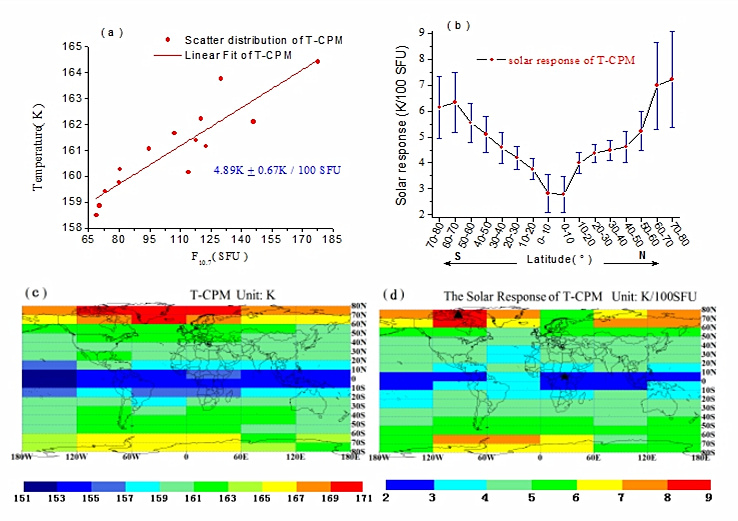
Mesopause, the layer separating the mesosphere from the thermosphere, is one of the main properties of the Earth’s upper atmosphere. The cold-point mesopause (CPM) is defined as the region where kinetic temperature is minimum, in which the transport and exchange of energy occur through subtle and complex processes.
The temperature of CPM (T-CPM) is the most important parameter to characterize this transition from the mesosphere to the thermosphere, and the variation of temperature may be related with the solar activities. If it were true, how would the solar activities affect the temperature of mesopause?
A study team led by Prof. WEI Heli in Atmospheric Optics Research Center in Anhui Institute of Optics and Fine Mechanics (AIOFM) of the Chinese Academy of Sciences conducted a research through which they gave the answer.
Dr. TANG Chaoli and his coworkers in the team analyzed the temperature profiles of the level 2A data set collected by the Sounding of the Atmosphere using Broadband Emission Radiometry (SABER) from 2002 to 2015.
Through the data analysis, the team presented: T-CPM is significantly sensitive to solar activity and the close relationship between solar activity and temperature structure in mesopause regions do exist.
Besides, there is a nonuniform latitudinal and longitudinal distribution of the response coefficients of T-CPM to the solar activities and the T-CPM changes due to solar activity changes which is assumed to be associated with the 11 year cycle.
Moreover, the global distribution of the response of T-CPM to solar activity and their correlation coefficient was firstly given. These results demonstrated the potentially significant physical mechanism which may link the 11 year solar cycle and the dynamic state of the mesopause.
This research entitled The response of the temperature of cold-point mesopause to solar activity based on SABER data set has been published in J. Geophys. Res. SpacePhysics.
This work was partly supported by the National Natural Science Foundation of China.

The response of the temperature of cold-point mesopause (T-CPM) to solar activity.
(a) The scatterplot of the annual mean of T-CPM and solar flux index (F10.7) during 2002-2015; (b) Latitudinal distribution of solar response of T-CPM, and the vertical bars show the fluctuation range of solar response; (c) Spatial distribution of 14yr average of T-CPM, and contour interval is 2K; (d) Spatial distribution of the solar response of T-CPM, and contour interval is 1 K/100SFU. (Image by TANG Chaoli)

86-10-68597521 (day)
86-10-68597289 (night)

86-10-68511095 (day)
86-10-68512458 (night)

cas_en@cas.cn

52 Sanlihe Rd., Xicheng District,
Beijing, China (100864)

